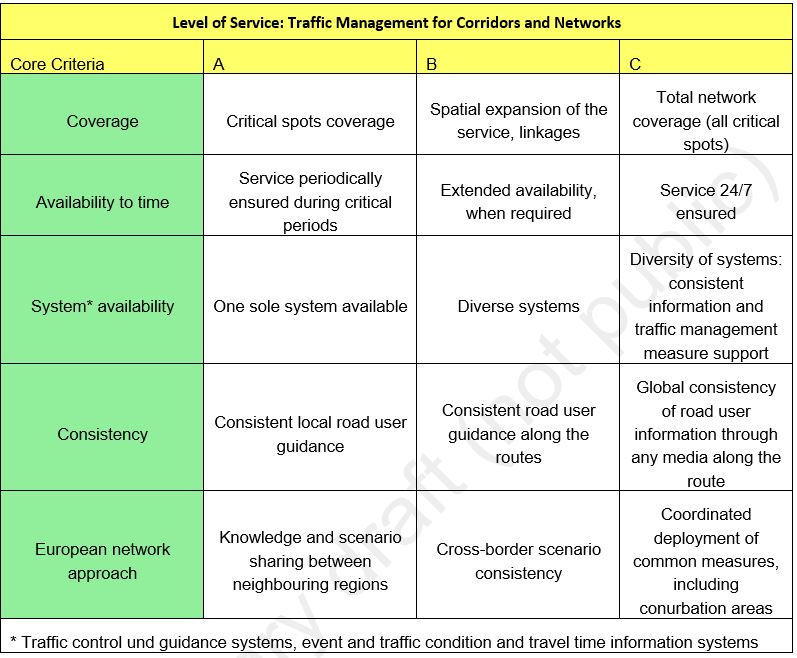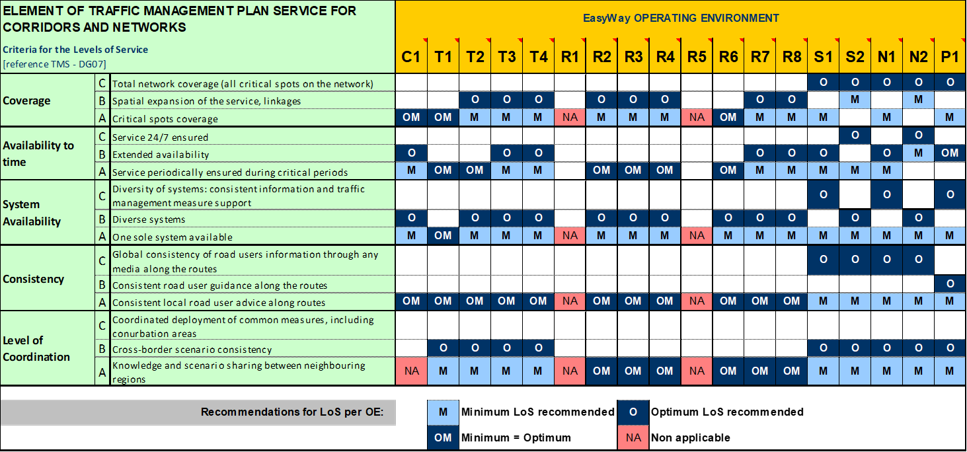Beneath content and functionality also the availability and the level of service of European ITS core services are subject of harmonisation: „road users shall be able to expect a certain Level of service offer in a specific Road environment!“.
The Concept of Operating Environments
An Operating Environment means the category of the road section classified according to types and service levels of ITS services typically expected to be operated and often provided on it by the road authorities and operators. Thereby, the Operating Environment is closely related to the expected service levels of the travellers and hauliers using the road section, the frequently occurring or threatening problems of the section, and the feasibility of possible ITS solutions to deal with these problems. The main properties of the road section affecting the Operating Environment are its physical characteristics, network typology, and the frequency and severity of traffic flow and road safety concerns on the section.
As presented in Table 3, there are 18 pre-defined Operating Environments where each Operating Environment is a combination of three criteria:
- Physical characteristics – Motorways, other 3/4 lane roads or 2-lane roads
- Network typology – Corridor, Network, Link or Critical spot
- Traffic characteristics – Traffic flow and road safety situations (with optional additions)
In addition, a specific road section may be characterized by attributes such as recurring weather problems, a particular sensitivity for environmental impacts or particular importance for freight transport. The classification method allows for such attributes to be added to the Operating Environment identified.
Full information on the Operating Environments can be found in the most recent version of the “Operating Environments for EasyWay Services” available in the EasyWay Deployment Guidelines package.
The Operating Environments proposed for EasyWay Core European ITS services are defined in a step-by-step approach, in which a road operator can allocate a road or a section of a road (a network element), taking into account the indicators listed above. It has to be noted that the Operating Environments are obtained through a qualitative and sequential approach, in order to make it simple and easy to use for any part of the road network.
The general layout (Table 3) is defined according to a letter code relating to the different physical characteristics, following a slightly modified TELTEN approach (ERTICO 1997[1])
- C for critical spots (bridges, tunnels, reversible lane sections, etc.)
- T for motorways
- R for roads
- S for motorway corridors or networks
- N for road corridors or networks
- P for peri-urban road networks
The EasyWay Operating Environments supporting guideline (EasyWay 2012[2]) gives hands-on recommendations on how to carry out the road network classification into operating environments in practice. The document also presents examples

[1] ERTICO 1997. TELTEN2 Final Report. Road Transport Telematics for better traffic management in Europe. CD-ROM. Brussels, March 1997
[2] EasyWay 2012. Operating Environments. Information and Communication Technologies, Supporting Guideline ICT-DG01. Version 02-00-00, December 2012.
The Operating Environments can be used in a number of ways. Four frequent uses are described below.
- Operating Environments and deployment priorities: By describing the critical spots and the sections with most severe problems and concerns, the Operating Environments can be used in selection of the parts of the road network for improvement measures as well as for prioritising between the different road segments and connections when the road operator is implementing different measures. For Europe-level assessments it would be preferable to use as consistent methodology for classifying the European road network into Operating Environments as possible.
- Operating Environments and Service Levels-tools for deployment planning: Operating Environments can also be used to steer and harmonise the implementation of Core ITS Services by the road operators in order to achieve harmonised service composition and harmonised service levels within a certain Operating Environment. To achieve this, there needs to be a description per Core ITS Service on adequate service levels to be applied in different Operating Environments. In EU EIP, the Operating Environments were also shown to be applicable to describe the service levels of digital and communication infrastructures facilitating C-ITS services and automated driving.
- Application of Operating Environments in Deployment Guidelines: Operating Environments are used in the Deployment Guidelines in order to guide towards a harmonised service composition. The aim is to achieve consistent service levels related to the type of road section, corridor or network in a way understandable also to the road users
- Operating Environments in Strategy and Road Map processes: By using the Operating Environments as the basis for the deployment strategies, road maps and action plans, rather than the physical road network, project partners can discuss deployment priorities in relation to an abstract network model, and then bring this information back into their national planning process. By adding the dimension of service level improvements and the dimension of time, the basic information required for an ITS deployment road map and action plan can be put in place.
The Level of service criteria concept
In order to be able to match the road and traffic-related classification of environmental conditions with levels of Service, a set of criteria is required according to which various service levels of ITS core service deployments can be differentiated. These criteria provide – for each ITS core service specifically – the so-called Level of Service criteria tables. An example of such a Level of Service criteria table provides Table 4 using the ITS core service „Traffic Management for corridors and networks“ as an example:

The Level of Service Criteria to Operating Environment relation
Once the two basic concepts „Operating Environment concept“ and „Level of Service concept“ have been created, both concepts can be mapped to each other. The result is a so-called „Level of Service to Operating Environment mapping table“, which depicts the minimum and optimum LoS which should be respected when the ITS-service is deployed. Table 5 shows a Level of Service to Operating Environment mapping table using the example Traffic management for corridors and networks service.
